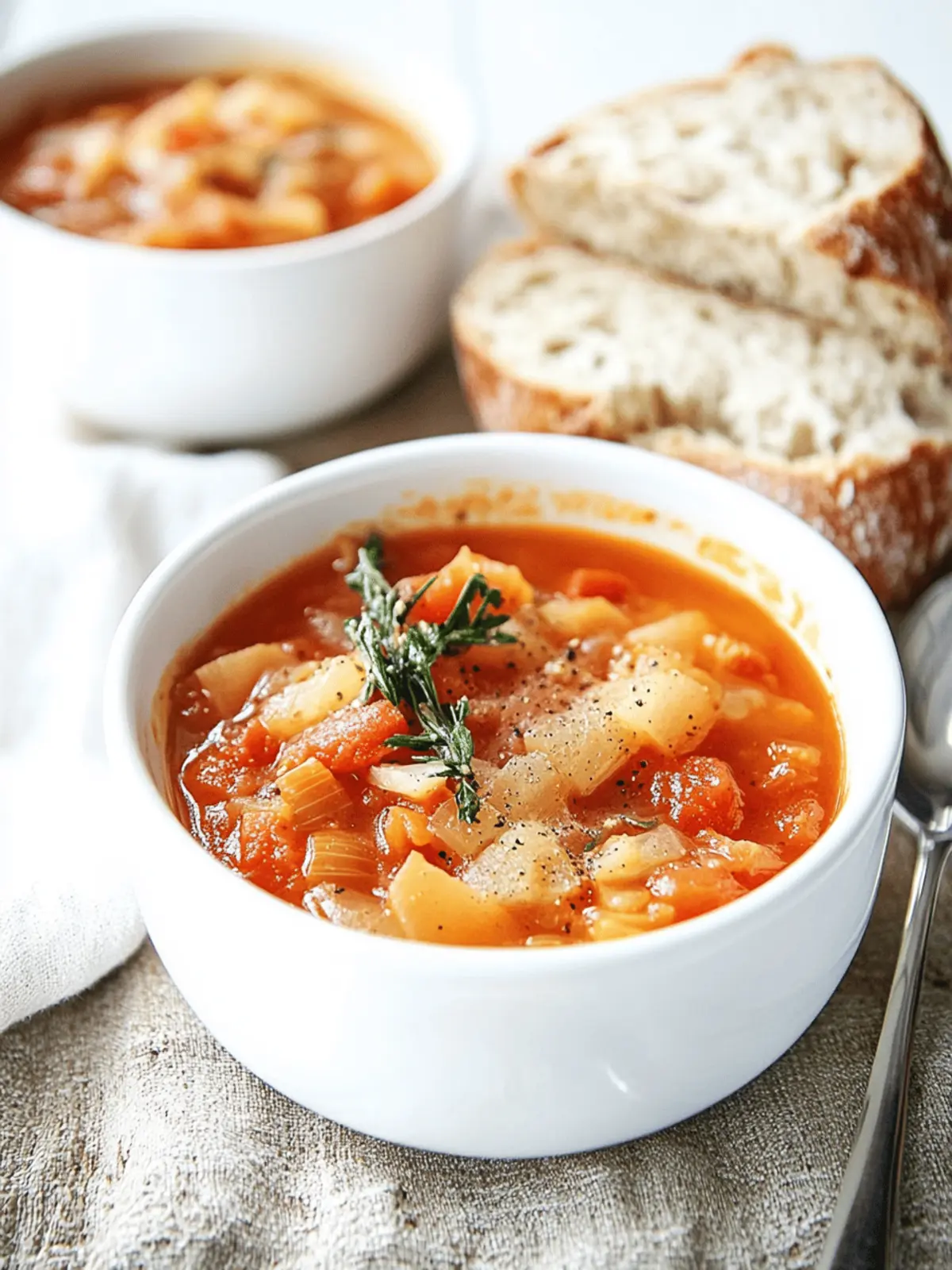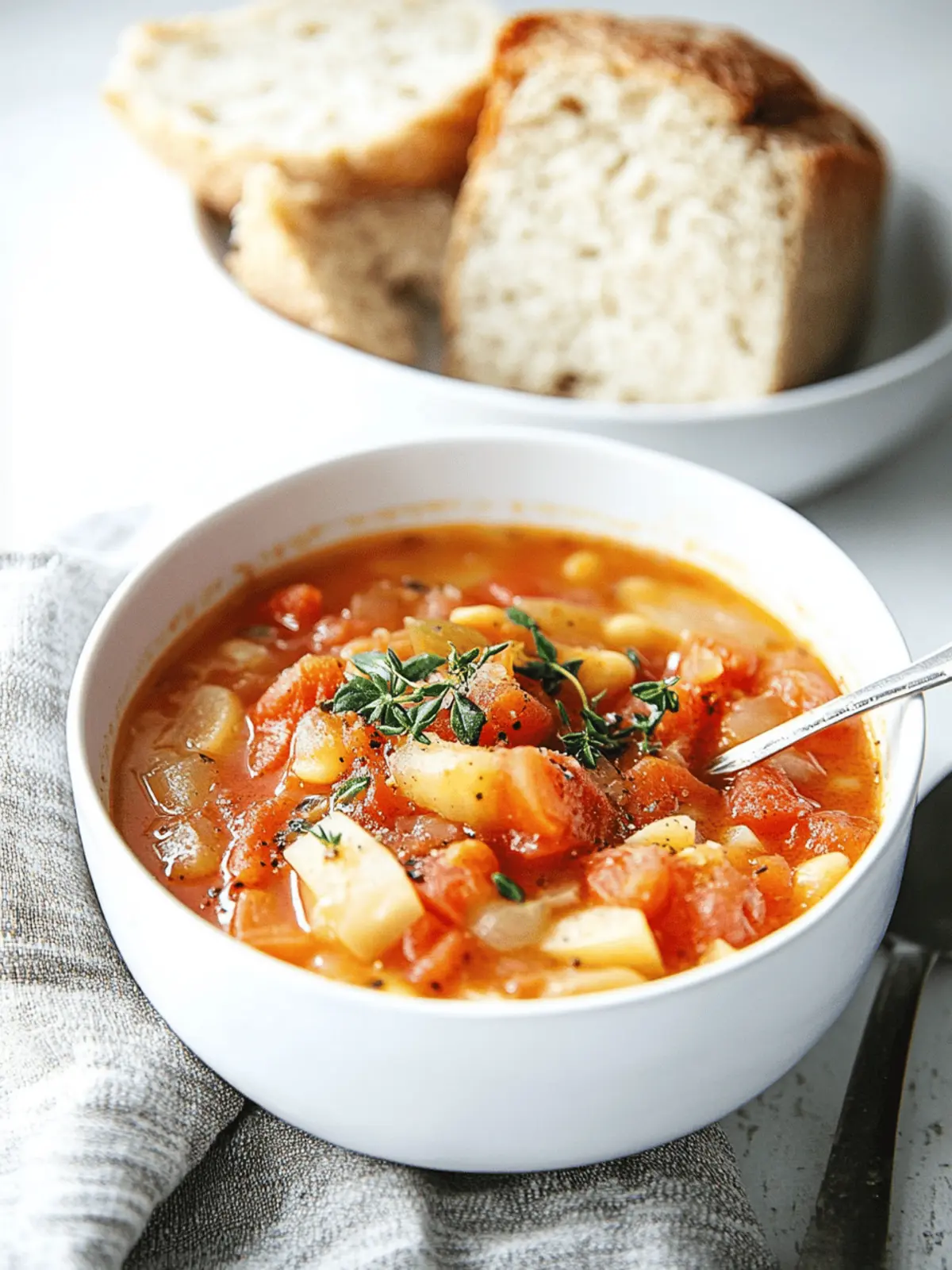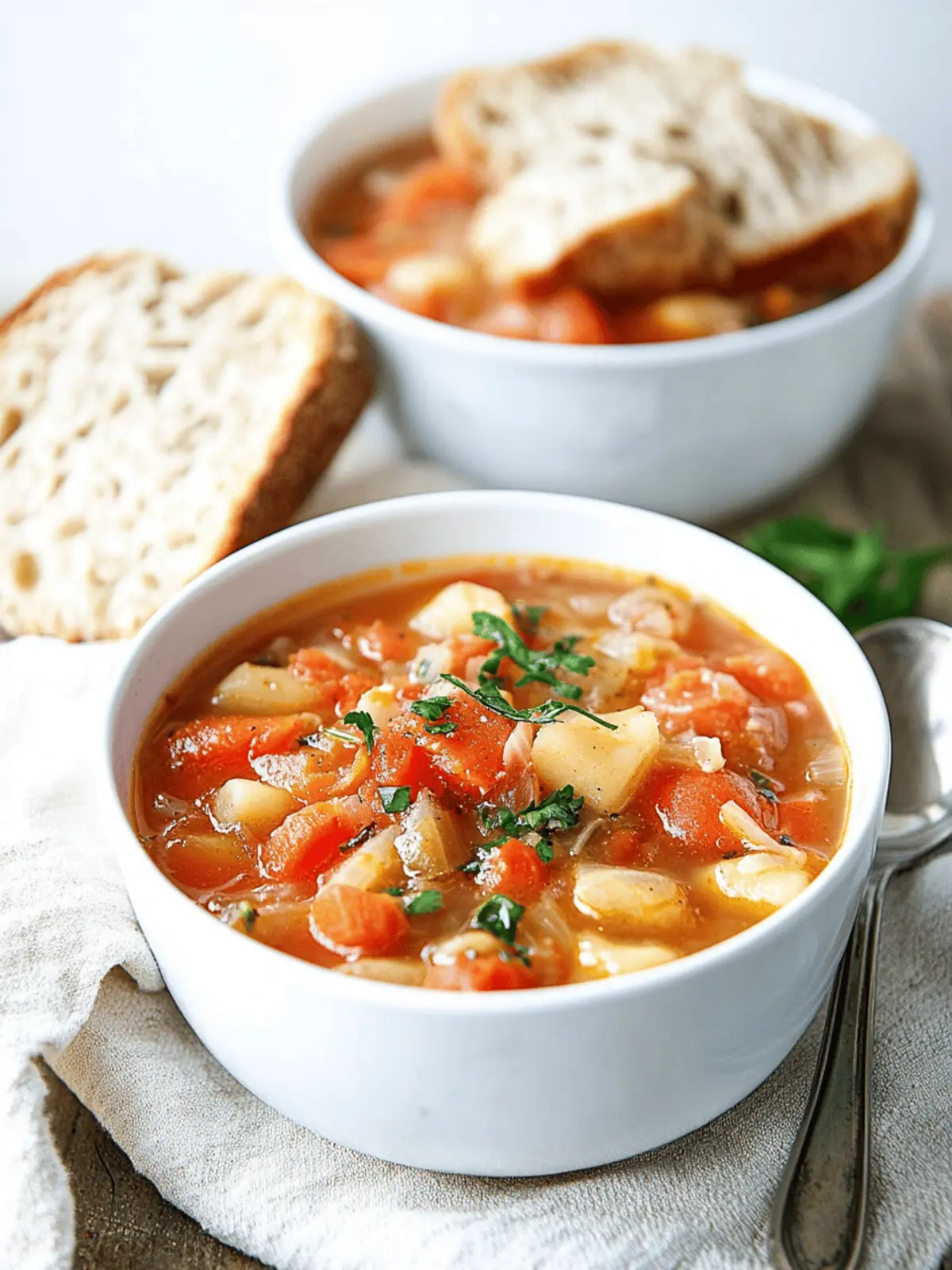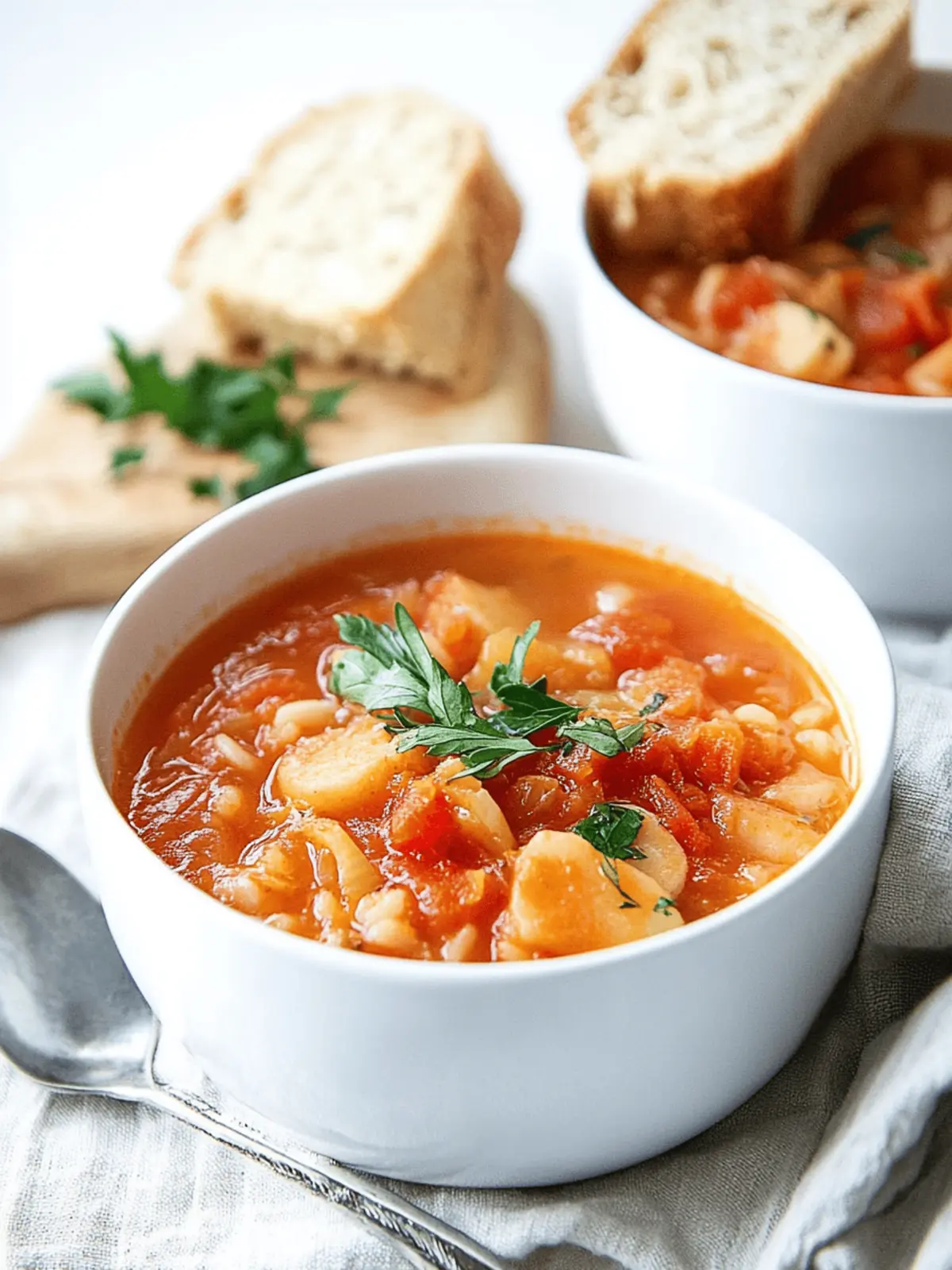As the chilly winds of winter sweep through my neighborhood, I find solace in a warm bowl of Hearty Winter Vegetable Soup. The vibrant colors of fresh vegetables bouncing around in the pot provide a feast for the eyes, while the rich, savory aroma envelopes my kitchen like a cozy blanket. This comforting soup embraces the essence of the season, blending earthy flavors with a hint of zest, making it perfect for any cold night.
I created this recipe as a simple solution to the drab meals that often accompany frigid temperatures—who wants to resort to another bland takeout? This dish is not only budget-friendly, but it also supports a healthy diet, packed full of nourishing ingredients that are kind to both your taste buds and your wallet. With an easy-to-follow method and the freedom to tweak ingredients based on what’s in your pantry, this soup is a flexible favorite that never disappoints. Join me in warming up this winter with a flavorful bowl that feels like a hug from the inside out!
Why is Winter Vegetable Soup a Must-Try?
Comforting and Warm: This soup’s rich, hearty flavors are perfect for chilly days, warming both body and soul.
Budget-Friendly: With simple, affordable ingredients, you can feed a crowd without breaking the bank.
Easy to Customize: Use whatever veggies you have on hand—this recipe encourages creativity!
Nutrient-Packed: Full of fiber, vitamins, and minerals, it keeps you feeling nourished and satisfied.
Perfect for Meal Prep: Make a batch in advance and enjoy quick, nutritious meals throughout the week.
Crowd-Pleaser: Everyone loves a good bowl of soup, making it ideal for family gatherings or cozy dinners with friends.
Winter Vegetable Soup Ingredients
For the Soup Base
• Butter – Adds richness; substitute with olive oil for a dairy-free version.
• Chopped Cabbage – Provides texture and bulk; any leafy green like kale can be used here.
• Chopped Cauliflower – Adds creaminess; swap with potatoes for a different flavor profile.
• Chopped Carrots – Sweetness and color; can be replaced with parsnips for a more earthy taste.
• Chopped Celery – Enhances flavor base; omit if unavailable.
• Chopped Onions – Essential for depth; leeks can be a milder alternative.
• Garlic (4 cloves, chopped) – Brings aromatic flavor; fresh garlic is preferred, but powdered garlic can substitute in a pinch.
For the Flavor
• Oregano (2 tsp) – Adds herby notes; thyme can also work well.
• Bay Leaves (2) – Infuses flavor; use dried herbs if fresh ones aren’t available.
• Salt & Pepper – Seasoning; adjust to taste.
For the Tomato Base
• Diced Tomatoes (1, 28-ounce can) – Adds acidity and depth; fresh tomatoes or tomato puree can also be used.
• Tomato Sauce (1, 680 mL can, plain) – Further develops the tomato base; can swap with vegetable broth if you prefer a thinner soup.
For Protein and Heartiness
• Chickpeas (1, 540 mL can) – Provides protein and texture; any beans, such as kidney or black beans, make a great substitute.
• Vegetable Broth (2 cups) – Adds liquid and enhances flavors; use water with additional spices if broth is unavailable.
• Cooked Noodles (1-2 cups, egg noodles used) – Offers heartiness; gluten-free pasta can replace regular noodles.
This Winter Vegetable Soup is a delightful way to embrace the season!
How to Make Winter Vegetable Soup
- Melt and Sauté: In a large soup pot, melt 2 tablespoons of butter over medium heat. Add chopped cabbage, cauliflower, carrots, celery, onions, and garlic—sauté until soft, about 5 minutes.
- Add Ingredients: Stir in 2 teaspoons of oregano, 2 bay leaves, salt, and pepper. Then add 1 can of diced tomatoes, 1 can of tomato sauce, 1 can of chickpeas, and 2 cups of vegetable broth.
- Simmer: Bring the mixture to a gentle simmer. Let it cook for approximately 30 minutes, until all the vegetables are tender and the flavors meld beautifully.
- Cook Noodles: In a separate pot, prepare 1-2 cups of cooked noodles according to package instructions, so they don’t soak up too much of the soup liquid.
- Combine and Serve: Just before serving, incorporate the cooked noodles into the soup, making sure they’re well mixed.
- Enjoy: Serve hot with fresh bread on the side for a comforting meal that warms the heart!
Optional: Garnish with freshly chopped parsley for a pop of color.
Exact quantities are listed in the recipe card below.
Make Ahead Options
These Hearty Winter Vegetable Soup preparations are perfect for busy home cooks who appreciate a comforting, homemade meal without the evening hassle! You can chop all the vegetables and even sauté them up to 24 hours in advance, just refrigerate them in an airtight container. Also, consider cooking the noodles separately and storing them in a well-sealed container until you’re ready to combine. When you’re set to serve, simply bring the soup back to a simmer, incorporate the prepped noodles, and enjoy a bowl full of warmth. This way, you’ll have all that hearty flavor ready to savor with minimal effort during your weeknight dinners!
Winter Vegetable Soup Variations
Invite your taste buds on a flavorful journey by customizing this comforting soup to suit your preferences!
-
Dairy-Free: Substitute butter with olive oil for a rich, dairy-free kick.
-
Leafy Greens Boost: Swap cabbage for kale or spinach to add vibrant colors and enhance nutrients.
-
Heartier Base: Replace chickpeas with shredded chicken or turkey for a protein-packed version.
-
Spicy Kick: Add a teaspoon of chili powder or crushed red pepper flakes for a warm, spicy surprise.
-
Root Veggie Twist: Experiment by using parsnips instead of carrots for an earthy sweetness that’s simply delightful.
-
Creamier Texture: Blend a portion of the soup and mix it back in for a silky mouthfeel that’s extra comforting.
-
Herb Infusion: Add fresh basil or parsley just before serving to brighten flavors and enhance freshness.
-
Seasonal Surprise: Incorporate seasonal vegetables like squash or sweet potatoes for added texture and flavor that celebrate the season.
Tips for the Best Winter Vegetable Soup
-
Sauté Vegetables Well: Make sure to sauté your vegetables until they’re soft for enhanced depth of flavor in the Winter Vegetable Soup.
-
Cook Noodles Separately: To keep your soup from becoming too thick or mushy, prepare the noodles in a separate pot and add them just before serving.
-
Season to Taste: Don’t forget to taste your soup before serving! Adjust salt and pepper to suit your palate for the best flavor experience.
-
Explore Seasonal Veggies: Feel free to experiment with seasonal vegetables like squash or sweet potatoes to add extra nutrition and flavor to your Winter Vegetable Soup.
-
Store Properly: Leftovers can be stored in the fridge for up to 5 days or frozen for up to 3 months—perfect for healthy meal prep!
-
Add Fresh Herbs: For a burst of freshness, stir in some chopped parsley or basil just before serving—this can elevate the dish beautifully!
What to Serve with Winter Vegetable Soup?
As the warmth of your Hearty Winter Vegetable Soup fills the air, consider these delightful side dishes to create a wholesome, comforting meal.
-
Crusty Bread: Perfect for dipping, warm bread complements the soup’s flavors and creates a satisfying texture contrast. The rustic crust offers a delightful crunch, while the soft inside soaks up the savory broth beautifully.
-
Grilled Cheese Sandwich: This classic pairing adds a melty, cheesy element that balances the soup’s earthiness, making every bite feel indulgent. Choose a hearty bread for grilling to enhance the overall experience.
-
Caesar Salad: With its crisp romaine and creamy dressing, this salad introduces crunch and a fresh burst of flavor that contrasts nicely with the warm soup. Toss in some croutons for added texture.
-
Roasted Root Vegetables: A side of caramelized carrots and parsnips brings sweetness and earthiness, further highlighting the soup’s vibrant veggie profile. Their natural sugars enhance the heartiness of your meal.
-
Pickled Vegetables: A tangy medley of pickled carrots, radishes, or beets adds brightness and acidity, closely balancing the rich flavors of the soup. This zesty addition invigorates the palate.
-
Herbed Rice: Fluffy rice with fresh herbs complements the soup while absorbing any extra broth. Consider adding lemon zest for a citrusy lift that brightens each spoonful.
-
Hot Apple Cider: As a beverage, warm apple cider infused with cinnamon brings cozy, seasonal spices that enhance the comforting nature of the meal. The sweetness pairs gently with the soup’s savory notes.
-
Chocolate Chip Cookies: For a touch of sweetness, serve warm chocolate chip cookies for dessert. Their soft, gooey texture brings the meal to a delightful close, satisfying sweet cravings.
-
Crispy Potato Wedges: Seasoned and baked, they offer a hearty crunch that pairs deliciously with the warm soup’s smoothness, creating a comforting and filling meal experience.
-
Seasonal Fruit Salad: A fresh, fruity side brings a refreshing contrast to the warm soup, with juicy bites brightening the overall flavor profile and adding a touch of sweetness to your meal.
How to Store and Freeze Winter Vegetable Soup
Fridge: Store leftovers in an airtight container in the fridge for up to 5 days. Reheat gently on the stove or microwave.
Freezer: This Winter Vegetable Soup freezes well! Portion into freezer-safe containers and store for up to 3 months. Thaw overnight in the fridge before reheating.
Reheating: When ready to enjoy, heat on the stove over medium until warmed through. You may need to add a splash of water or broth to loosen the consistency.
Notes: For best flavor, avoid storing cooked noodles in the soup. Cook them fresh when ready to serve!
Winter Vegetable Soup Recipe FAQs
How do I choose the right vegetables for my soup?
Absolutely! The best vegetables are those that are fresh and in season. Look for firm, brightly colored veggies without dark spots or blemishes. For example, when selecting cabbage, choose one that feels heavy for its size; similarly, a cauliflower should be compact without any browning. Don’t hesitate to mix and match based on what’s in your fridge!
How should I store leftover Winter Vegetable Soup?
Very! Store your soup in an airtight container in the refrigerator for up to 5 days. Make sure to let it cool down first to maintain freshness. If you want to keep it longer, consider freezing it. Just be sure to leave out the noodles if you’re planning to store it—this helps prevent them from becoming mushy.
Can I freeze Winter Vegetable Soup?
Yes, you can! To freeze your soup, wait until it has completely cooled, then portion it into freezer-safe containers. It will keep well for up to 3 months. When you’re ready to enjoy it, simply thaw it overnight in the refrigerator before reheating on the stove. If the soup is too thick, add a splash of vegetable broth or water while reheating.
What should I do if my soup is too thick?
I often find that if my soup becomes too thick, it’s easy to fix! Simply add a bit of vegetable broth or water while it’s simmering on the stove until you reach your desired consistency. Stir well to make sure everything is mixed evenly, and don’t forget to taste and adjust the seasoning if needed!
Are there any dietary considerations I should keep in mind with this soup?
Absolutely! This Winter Vegetable Soup is vegetarian, making it suitable for most diets. If you have nut allergies, double-check any broth used. For gluten sensitivities, opt for gluten-free pasta substitutes. And remember, when using canned chickpeas, rinse them thoroughly to reduce sodium content. Always feel free to adjust the ingredients based on your dietary needs!
Can I add protein to my Winter Vegetable Soup?
Very much so! If you’re looking to incorporate some additional protein, shredded chicken or turkey makes a delightful addition. Alternatively, keep it plant-based with lentils or more beans, like black or kidney beans. Just stir them in during the last 10 minutes of simmering to heat through. The more the merrier in terms of flavor and nutrition!

Cozy Up with Hearty Winter Vegetable Soup for Cold Days
Ingredients
Equipment
Method
- Melt 2 tablespoons of butter in a large pot over medium heat. Sauté chopped cabbage, cauliflower, carrots, celery, onions, and garlic for about 5 minutes until soft.
- Stir in 2 teaspoons of oregano, 2 bay leaves, salt, and pepper. Add 1 can of diced tomatoes, 1 can of tomato sauce, 1 can of chickpeas, and 2 cups of vegetable broth.
- Bring to a gentle simmer and cook for approximately 30 minutes until all vegetables are tender.
- Prepare 1-2 cups of cooked noodles separately according to package instructions.
- Incorporate the cooked noodles into the soup just before serving.
- Serve hot with fresh bread on the side.








